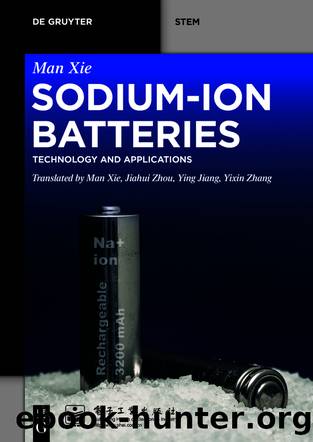Sodium-Ion Batteries by Man Xie Feng Wu Yongxin Huang

Author:Man Xie, Feng Wu, Yongxin Huang
Language: eng
Format: epub
Publisher: De Gruyter
Published: 2022-06-23T10:55:49.308000+00:00
Figure 4.29: TEM images of sea urchin-like CoSe2 [144].
4.3.4
Metal phosphide anode materials
Metal phosphide is a promising anode material for sodium-ion batteries. Similar to metal oxides and metal sulfides, metal phosphides undergo conversion reactions with metal Na to produce metal monomers and Na3P. The uniform distribution of metal monomers in Na3P speeds up the kinetic process of the Na3P oxidation reaction, giving metal phosphides good electrochemical performance when used as anode materials for sodium-ion batteries. However, the defects of metal phosphides also limit their own development. On the one hand, the low electrical conductivity of metal phosphide makes its active material utilization in sodium-ion batteries low, showing a capacity much lower than its theoretical capacity, and on the other hand, during the charging and discharging alloying process, the large volume change destroys the original microscopic morphology of the electrode material, resulting in poor cycling stability. So far, the improvement scheme mainly focuses on the compounding of phosphorus-based materials with carbon materials and the construction of nanostructures. The carbon material, as a material with good electrical conductivity, can improve the overall stability of the electrode material, while the nanoscale particles can reduce the ion/electron transport path, and the reasonable nanostructure construction can protect the microscopic morphology of the metal phosphide from being destroyed during the charging and discharging process.
These metal phosphides are broadly divided into two types based on whether the metals in the metal phosphides are electrochemically active: inactive metal phosphides and active metal phosphides. Inactive metal phosphides include Co-P (CoP), Cu-P (CuP2, Cu3P), Fe-P (FeP, FeP4), and Ni-P (NiP3). The use of electrochemically inert metals, such as Cu, Fe or Ni, does not contribute to the capacity of these metal phosphides, and also reduces the theoretical capacity of the metal phosphides. However, metals have high electrical conductivity, which helps to fully utilize the P capacity. At the same time, these metal inert phosphides have a relatively small volume expansion. Their charging and discharging mechanism is
(4.30)
NiP3/carbon nanotubes (CNTs) composites were synthesized by a simple ball milling method, which consists of NiP3 particles chemically bonded to functionalized CNTs [147]. The addition of conductive carbon nanotubes increased the Na+ diffusion coefficient by two orders of magnitude, from 9.15âÃâ10â17 cm2â·âSâ1 to 2.91âÃâ10â15 cm2â·âSâ1, and the charge transfer resistance was reduced to 1/6th of the original one. The NiP3/CNTs composite negative electrode has a high initial reversible specific capacity of 853 mA h gâ1 and maintains more than 80% capacity after 120 cycles at a current density of 200 mA gâ1, and the high multiplicative capacity of 363.8 mA h gâ1 remains after 200 cycles at a current density of 1,600 mA gâ1. Density functional theory (DFT) calculations, combined with molecular dynamics (AIMD), and simulations reveal strong chemical interactions between the red P in NiP3 and the functional groups on the carbon nanotubes through ball milling, to form P-C and P-O-C bonds. Figure 4.30 shows the X-ray diffraction (XRD) patterns of NiP3, CNTs and NiP3/CNT composites. All sharp peaks match well with the crystalline NiP3 (JCPDS: 98â152-6485, cubic), and the broad peak at ~â25.
Download
This site does not store any files on its server. We only index and link to content provided by other sites. Please contact the content providers to delete copyright contents if any and email us, we'll remove relevant links or contents immediately.
The Complete Stick Figure Physics Tutorials by Allen Sarah(7310)
Secrets of Antigravity Propulsion: Tesla, UFOs, and Classified Aerospace Technology by Ph.D. Paul A. Laviolette(5311)
Thing Explainer by Randall Munroe(3877)
The River of Consciousness by Oliver Sacks(3543)
The Order of Time by Carlo Rovelli(3145)
How To by Randall Munroe(3038)
A Brief History of Time by Stephen Hawking(2962)
I Live in the Future & Here's How It Works by Nick Bilton(2938)
The Great Unknown by Marcus du Sautoy(2649)
What If?: Serious Scientific Answers to Absurd Hypothetical Questions by Randall Munroe(2637)
Midnight in Chernobyl by Adam Higginbotham(2485)
Blockchain: Ultimate Step By Step Guide To Understanding Blockchain Technology, Bitcoin Creation, and the future of Money (Novice to Expert) by Keizer Söze(2450)
Networks: An Introduction by Newman Mark(2360)
The Meaning of it All by Richard Feynman(2300)
Easy Electronics by Charles Platt(2282)
The Tao of Physics by Fritjof Capra(2231)
Midnight in Chernobyl: The Untold Story of the World's Greatest Nuclear Disaster by Adam Higginbotham(2179)
When by Daniel H Pink(2084)
Introducing Relativity by Bruce Bassett(2080)
